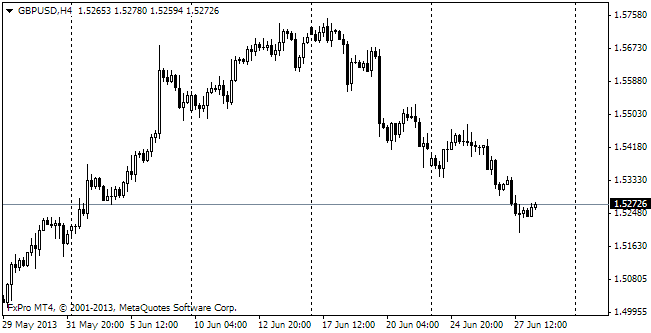EUR/USD
The single currency was depreciating all day long yesterday. The pair managed to stop its decline only close to 1.3520. Now trading is held about 10 pips above this local low. Despite the fact that the considerable part of the decline occurred after Yellen's speech before the Congress on Tuesday, it is hard to find connection between these events as other currencies don't show such dynamics. The cable, the aussie and the yen suffered some losses yesterday and the Loonie didn't manage to grow. The reason for the pressure put on the euro is seen in the policy easing in the eurozone, carried out a bit over a month ago. The decrease in the interest rates and absence of sterilization are gradually but steadily sapping strength of the single currency. And this gap is very likely to extend as the approach of the Fed's first rate increase will impact the yields of the US assets in advance, making them more attractive and boosting demand for the dollar assets. The higher price indexes from the USA will surely only support USD. Thus, yesterday's data on producer prices indicated growth by 0.4% m/m instead of the expected 0.2%. The annual growth rate slowed down less than forecasted by analysts: to 1.9% instead of 1.8%. In May this index made 2.0%. The industrial production and capacity utilization rate showed less growth than expected, but are still quite high. This June the Industrial Production Index proved to be by 4.3% higher than a year ago. The manufacturing sectors grew by 3.5% against June 2013. The Capacity Utilization Rate remains at the same level as a month ago, i.e. 79.1%. As you remember, the rates exceeding 80% can signal about the overheated condition in the market, forcing the Fed to toughen the policy.
GBP/USD
The British currency survived the pressure, created by specks of poor data in the generally positive employment picture. As reported yesterday, the number of people getting unemployment claims dropped by 36.3K in May. And the number of people seeking unemployment claims shrank to 3.1%, which is the lowest level since October 2008. Here we clearly see the analogy with the fact that the British pound is now of the highest rate since October 2008. The only disappointing thing about the report was the rate of earnings growth. The average earnings rose just by 0.3% in comparison with the previous year. Mainly due to the reduction of bonuses. With bonuses excluded the growth makes 0.7%. The British employers don't hurry to fight for the personnel despite sharp employment growth over the recent year. However, this disharmony will hardly last for long.

USD/JPY
Yesterday the Japanese yen slowed down its depreciation against the dollar, then lost all the momentum at the end of the day and today has set out in the upward direction. So, the dollar/yen has started to fall without even trying to break through 102.0 or even through the 200-day MA.

USD/CAD
The canadian dollar found enough strength to stop its decline against USD, despite a very cautious tone of the commentary to the interest rate decision. The initial impulse to sell quickly reversed, leading the pair away from 1.0790. Now trading is held at 1.0730. Partly it has been supported by the positive performance of oil and gold. Both of the instruments have space for growth, which can support the Canadian dollar despite traders' attempts to develop a full-scale rally of USD.
